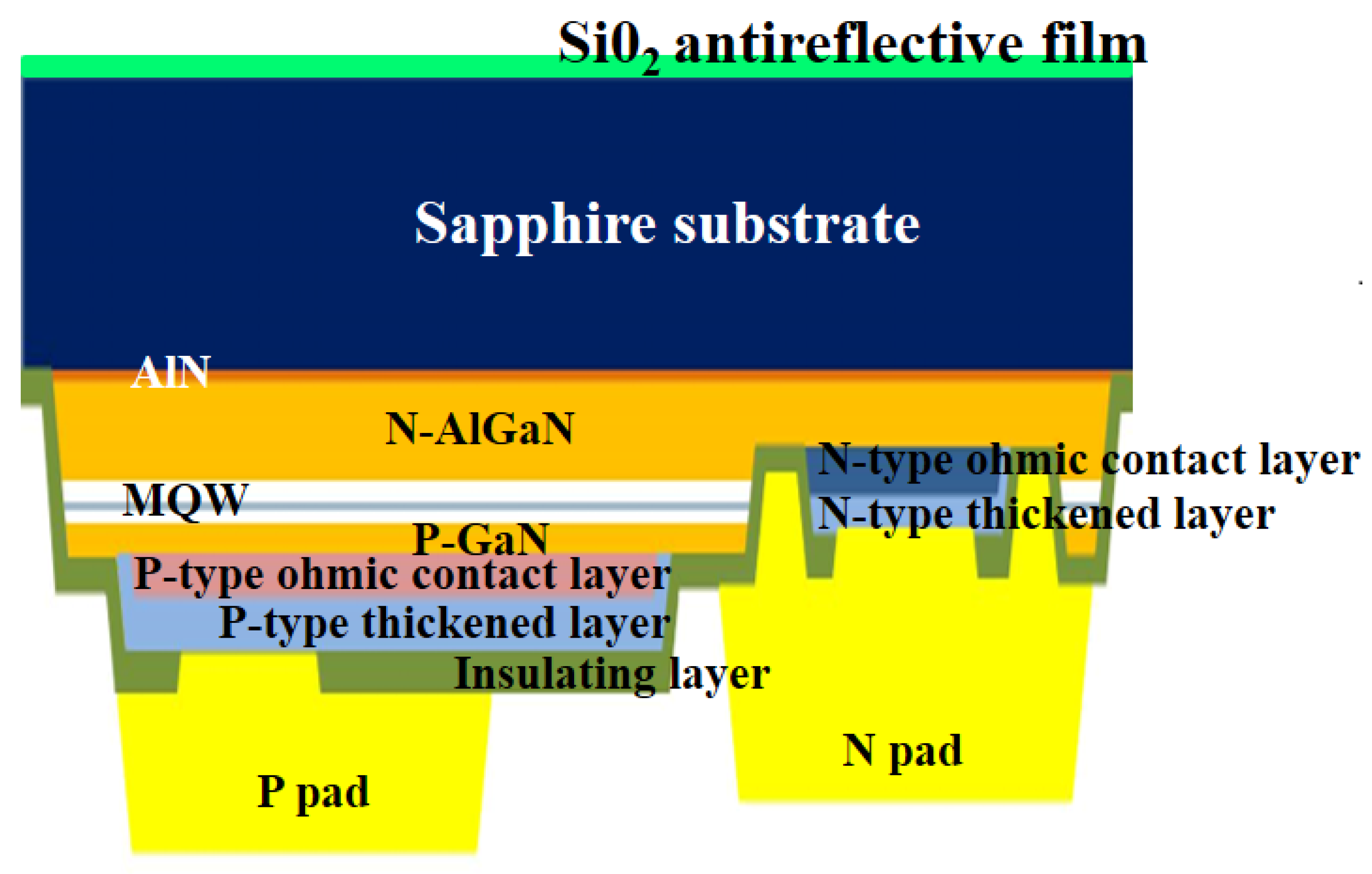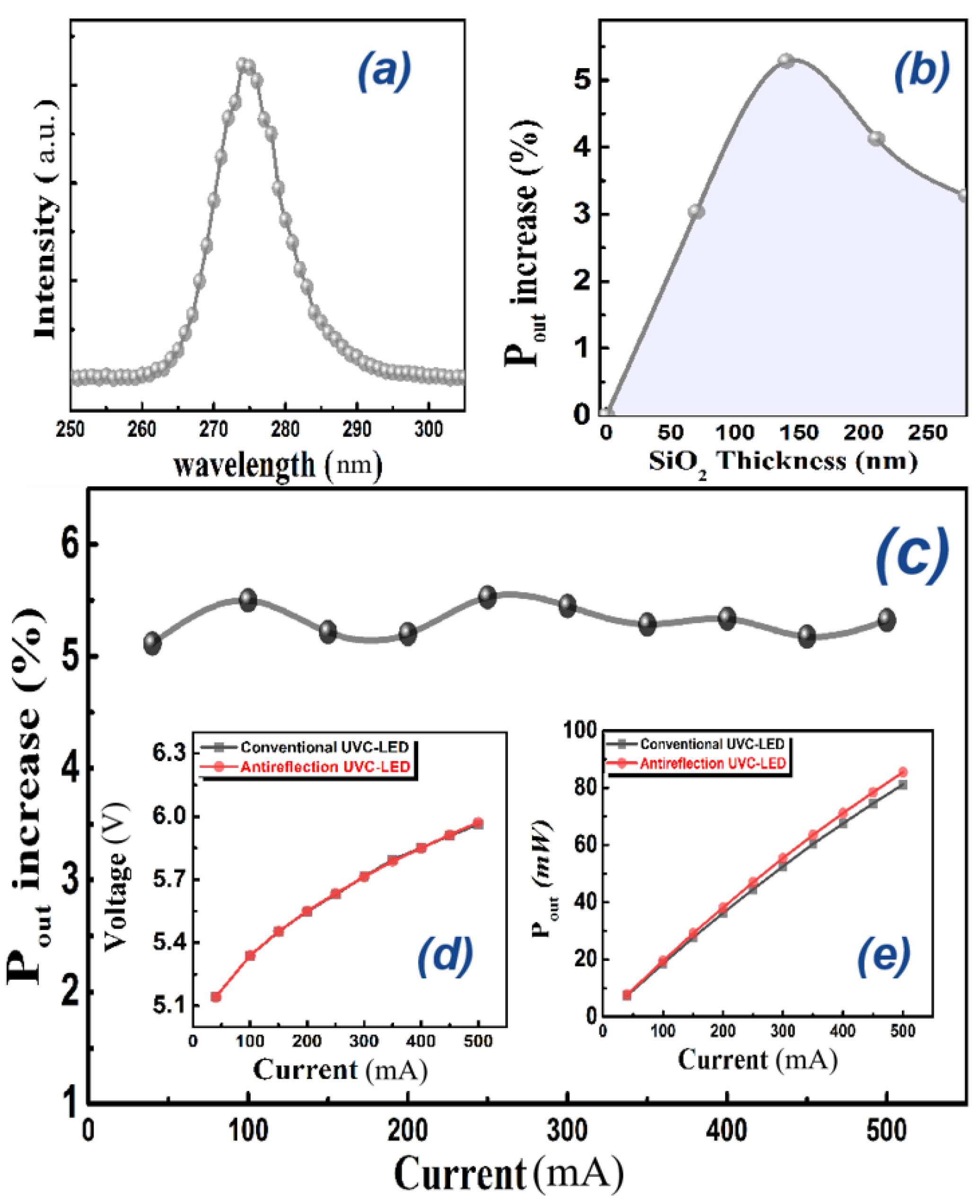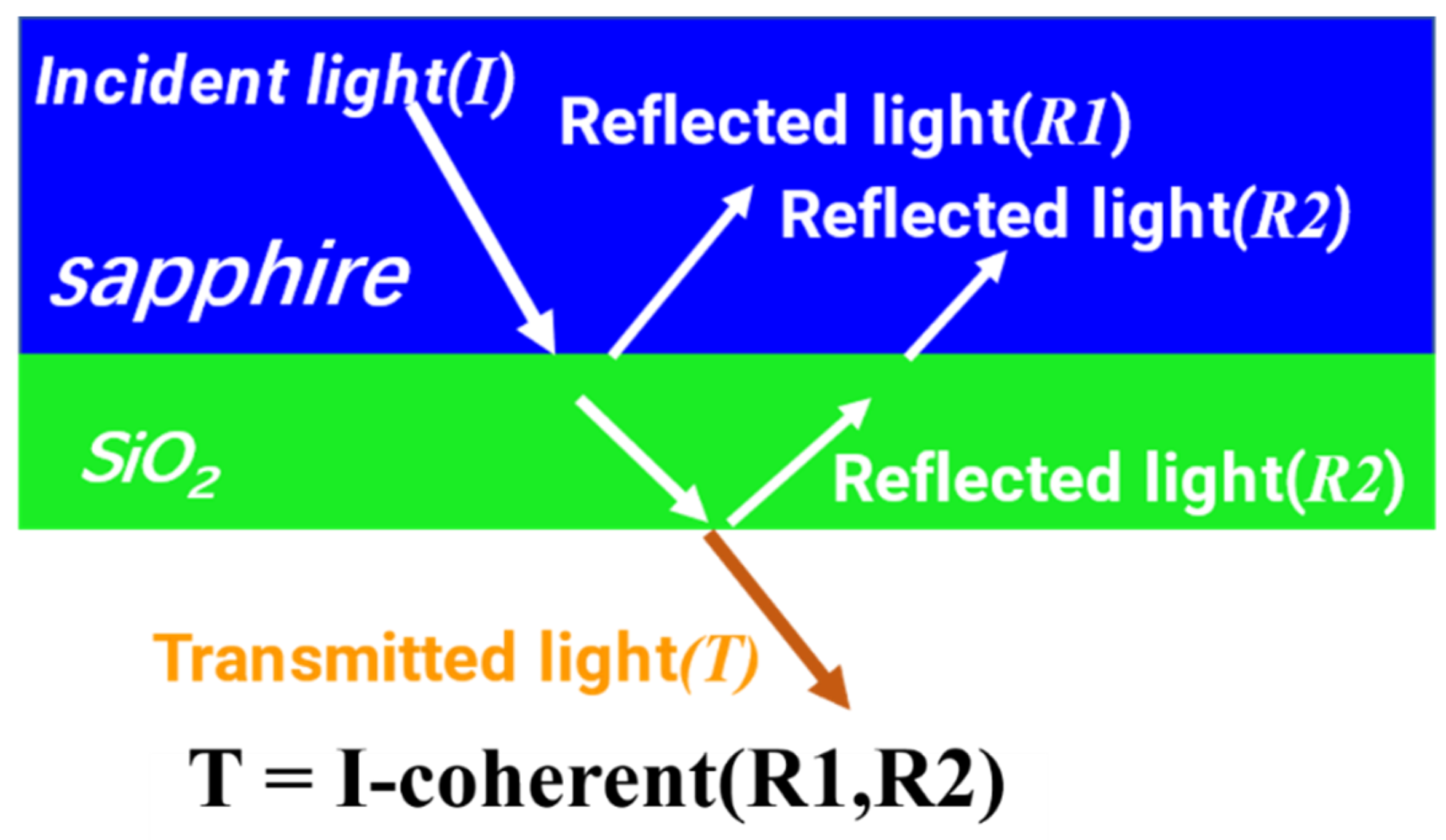Enhancement of Light Extraction Efficiency of UVC-LED by SiO2 Antireflective Film
Abstract
:1. Introduction
2. Experiments
3. Results and Discussion
4. Conclusions
Author Contributions
Funding
Institutional Review Board Statement
Informed Consent Statement
Data Availability Statement
Conflicts of Interest
References
- Tsuzuki, H.; Mori, F.; Takeda, K.; Ichikawa, T.; Iwaya, M.; Kamiyama, S.; Amano, H.; Akasaki, I.; Yoshida, H.; Kuwabara, M.; et al. High-performance UV emitter grown on high-crystalline-quality AlGaN underlying layer. Phys. Status Solidi (A) 2009, 206, 1199–1204. [Google Scholar] [CrossRef]
- Hirayama, H.; Maeda, N.; Fujikawa, S.; Toyoda, S.; Kamata, N. Recent progress and future prospects of AlGaN-based high-efficiency deep-ultraviolet light-emitting diodes. Jpn. J. Appl. Phys. 2014, 53, 100209. [Google Scholar] [CrossRef]
- Würtele, M.A.; Kolbe, T.; Lipsz, M.; Külberg, A.; Weyers, M.; Kneissl, M.; Jekel, M.J.W.R. Application of GaN-based ultraviolet-C light emitting diodes–UV LEDs–for water disinfection. Water Res. 2011, 45, 1481–1489. [Google Scholar] [CrossRef] [PubMed]
- Nagasawa, Y.; Hirano, A. A review of AlGaN-based deep-ultraviolet light-emitting diodes on sapphire. Appl. Sci. 2018, 8, 1264. [Google Scholar] [CrossRef] [Green Version]
- Ryu, H.Y.; Choi, I.G.; Choi, H.S.; Shim, J.I. Investigation of light extraction efficiency in AlGaN deep-ultraviolet light-emitting diodes. Appl. Phys. Express 2013, 6, 062101. [Google Scholar] [CrossRef]
- Hirayama, H.; Fujikawa, S.; Kamata, N. Recent progress in AlGaN-based deep-UV LEDs. Electron. Commun. Jpn. 2015, 98, 1–8. [Google Scholar] [CrossRef]
- Huang, C.; Wang, Y.; Li, X.; Ren, L.; Zhao, J.; Hu, Y.; Zhang, L.; Fan, G.; Xu, J.; Gu, X.; et al. Clinical features of patients infected with 2019 novel coronavirus in Wuhan, China. Lancet 2020, 395, 497–506. [Google Scholar] [CrossRef] [Green Version]
- Minamikawa, T.; Koma, T.; Suzuki, A.; Mizuno, T.; Nagamatsu, K.; Arimochi, H.; Tsuchiya, K.; Matsuoka, K.; Yasui, T.; Yasutomo, K.; et al. Quantitative evaluation of SARS-CoV-2 inactivation using a deep ultraviolet light-emitting diode. Sci. Rep. 2021, 11, 5070. [Google Scholar] [CrossRef]
- Mondal, R.K.; Adhikari, S.; Chatterjee, V.; Pal, S. Recent advances and challenges in AlGaN-based ultra-violet light emitting diode technologies. Mater. Res. Bull. 2021, 140, 111258. [Google Scholar] [CrossRef]
- Ye, Z.T.; Cheng, Y.H.; Hung, L.W.; Hsu, K.H.; Hu, Y.C. Light Guide Layer Thickness Optimization for Enhancement of the Light Extraction Efficiency of Ultraviolet Light–Emitting Diodes. Nanoscale Res. Lett. 2021, 16, 1405. [Google Scholar] [CrossRef]
- Ma, Z.; Cao, H.; Lin, S.; Li, X.; Zhao, L. Degradation and failure mechanism of AlGaN-based UVC-LEDs. Solid-State Electron. 2019, 156, 92–96. [Google Scholar] [CrossRef]
- Sun, H.; Li, X. Recent Advances on III-Nitride Nanowire Light Emitters on Foreign Substrates–Toward Flexible Photonics. Phys. Status Solidi (A) 2019, 216, 1800420. [Google Scholar] [CrossRef]
- Kneissl, M.; Seong, T.Y.; Han, J.; Amano, H. The emergence and prospects of deep-ultraviolet light-emitting diode technologies. Nat. Photonics 2019, 13, 233–244. [Google Scholar] [CrossRef]
- Ren, Z.; Yu, H.; Liu, Z.; Wang, D.; Xing, C.; Zhang, H.; Huang, C.; Long, S.; Sun, H. Band engineering of III-nitride-based deep-ultraviolet light-emitting diodes: A review. J. Phys. D Appl. Phys. 2019, 53, 073002. [Google Scholar] [CrossRef]
- Takano, T.; Mino, T.; Sakai, J.; Noguchi, N.; Tsubaki, K.; Hirayama, H. Deep-ultraviolet light-emitting diodes with external quantum efficiency higher than 20% at 275 nm achieved by improving light-extraction efficiency. Appl. Phys. Express 2017, 10, 031002. [Google Scholar] [CrossRef]
- Lachab, M.; Asif, F.; Zhang, B.; Ahmad, I.; Heidari, A.; Fareed, Q.; Adivarahan, V.; Khan, A. Enhancement of light extraction efficiency in sub-300 nm nitride thin-film flip-chip light-emitting diodes. Solid-State Electron. 2013, 89, 156–160. [Google Scholar] [CrossRef]
- Cho, H.K.; Ostermay, I.; Zeimer, U.; Enslin, J.; Wernicke, T.; Einfeldt, S.; Weyers, M. Highly reflective p-contacts made of Pd-Al on deep ultraviolet light-emitting diodes. IEEE Photonics Technol. Lett. 2017, 29, 2222–2225. [Google Scholar] [CrossRef]
- Gao, Y.; Chen, Q.; Zhang, S.; Long, H.; Dai, J.; Sun, H.; Chen, C. Enhanced light extraction efficiency of AlGaN-based deep ultraviolet light-emitting diodes by incorporating high-reflective n-type electrode made of Cr/Al. IEEE Trans. Electron Devices 2019, 66, 2992–2996. [Google Scholar] [CrossRef]
- Kashima, Y.; Maeda, N.; Matsuura, E.; Jo, M.; Iwai, T.; Morita, T.; Kokubo, M.; Tashiro, T.; Kamimura, R.; Osada, Y.; et al. High external quantum efficiency (10%) AlGaN-based deep-ultraviolet light-emitting diodes achieved by using highly reflective photonic crystal on p-AlGaN contact layer. Appl. Phys. Express 2017, 11, 012101. [Google Scholar] [CrossRef]
- Nakashima, T.; Takeda, K.; Shinzato, H.; Iwaya, M.; Kamiyama, S.; Takeuchi, T.; Akasaki, I.; Amano, H. Combination of Indium–Tin Oxide and SiO2/AlN Dielectric Multilayer Reflective Electrodes for Ultraviolet-Light-Emitting Diodes. Jpn. J. Appl. Phys. 2013, 52, 08JG07. [Google Scholar] [CrossRef]
- Dong, P.; Yan, J.; Wang, J.; Zhang, Y.; Geng, C.; Wei, T.; Cong, P.; Zhang, Y.; Zeng, J.; Tian, Y.; et al. 282-nm AlGaN-based deep ultraviolet light-emitting diodes with improved performance on nano-patterned sapphire substrates. Appl. Phys. Lett. 2013, 102, 241113. [Google Scholar] [CrossRef]
- Pernot, C.; Kim, M.; Fukahori, S.; Inazu, T.; Fujita, T.; Nagasawa, Y.; Hirano, A.; Ippommatsu, M.; Iwaya, M.; Kamiyama, S. Improved efficiency of 255–280 nm AlGaN-based light-emitting diodes. Appl. Phys. Express 2010, 3, 061004. [Google Scholar] [CrossRef]
- Lee, J.W.; Park, J.H.; Kim, D.Y.; Schubert, E.F.; Kim, J.; Lee, J.; Kim, Y.L.; Park, Y.; Kim, J.K. Arrays of truncated cone AlGaN deep-ultraviolet light-emitting diodes facilitating efficient outcoupling of in-plane emission. ACS Photonics 2016, 3, 2030–2034. [Google Scholar] [CrossRef]
- Zhang, Y.; Xie, H.; Zheng, H.; Wei, T.; Yang, H.; Li, J.; Yi, X.; Song, X.; Wang, G.; Li, J. Light extraction efficiency improvement by multiple laser stealth dicing in InGaN-based blue light-emitting diodes. Opt. Express 2012, 20, 6808–6815. [Google Scholar] [CrossRef]
- Chen, Q.; Zhang, H.; Dai, J.; Zhang, S.; Wang, S.; He, J.; Liang, R.; Zhang, Z.H.; Chen, C. Enhanced the optical power of AlGaN-based deep ultraviolet light-emitting diode by optimizing mesa sidewall angle. IEEE Photonics J. 2018, 10, 6100807. [Google Scholar] [CrossRef]
- Peng, Y.; Guo, X.; Liang, R.; Cheng, H.; Chen, M. Enhanced light extraction from DUV-LEDs by AlN-doped fluoropolymer encapsulation. IEEE Photonics Technol. Lett. 2017, 29, 1151–1154. [Google Scholar] [CrossRef]
- Guo, Y.; Zhang, Y.; Yan, J.; Xie, H.; Liu, L.; Chen, X.; Hou, M.; Qin, Z.; Wang, J.; Li, J. Light extraction enhancement of AlGaN-based ultraviolet light-emitting diodes by substrate sidewall roughening. Appl. Phys. Lett. 2017, 111, 011102. [Google Scholar] [CrossRef]






Publisher’s Note: MDPI stays neutral with regard to jurisdictional claims in published maps and institutional affiliations. |
© 2022 by the authors. Licensee MDPI, Basel, Switzerland. This article is an open access article distributed under the terms and conditions of the Creative Commons Attribution (CC BY) license (https://creativecommons.org/licenses/by/4.0/).
Share and Cite
Wang, Y.; Lv, Z.; Qi, S.; Liu, Y.; Long, H. Enhancement of Light Extraction Efficiency of UVC-LED by SiO2 Antireflective Film. Crystals 2022, 12, 928. https://doi.org/10.3390/cryst12070928
Wang Y, Lv Z, Qi S, Liu Y, Long H. Enhancement of Light Extraction Efficiency of UVC-LED by SiO2 Antireflective Film. Crystals. 2022; 12(7):928. https://doi.org/10.3390/cryst12070928
Chicago/Turabian StyleWang, Yu, Zhenxing Lv, Shengli Qi, Yazhu Liu, and Hao Long. 2022. "Enhancement of Light Extraction Efficiency of UVC-LED by SiO2 Antireflective Film" Crystals 12, no. 7: 928. https://doi.org/10.3390/cryst12070928
APA StyleWang, Y., Lv, Z., Qi, S., Liu, Y., & Long, H. (2022). Enhancement of Light Extraction Efficiency of UVC-LED by SiO2 Antireflective Film. Crystals, 12(7), 928. https://doi.org/10.3390/cryst12070928





